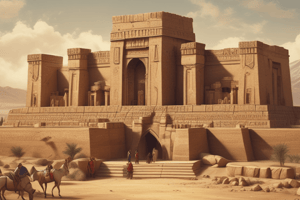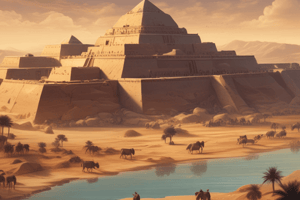Podcast
Questions and Answers
ما هو أهم تطور في المدن السومرية؟
ما هو أهم تطور في المدن السومرية؟
- نظام الري ذاتي
- نظام الحكمات الدينية
- نظام الكتابة المغزلي (correct)
- نظام الاقتصاد المهني
ما هو أبرز إنجاز لأسرة أكد؟
ما هو أبرز إنجاز لأسرة أكد؟
- تأسيس نظام الديانة الواحدة
- تأسيس نظام حكم متعدد الأعراق (correct)
- تأسيس نظام الكتابة المغزلية
- تأسيس نظام الاقتصاد المهني
ما هو أبرز تطور في الثقافة البابلية؟
ما هو أبرز تطور في الثقافة البابلية؟
- تطوير العمارة والهندسة المعمارية
- تطوير الأدب والشعر البابلي
- تطوير نظام القانون المدني
- تطوير علم الفلك والرصد (correct)
ما هو أبرز ملوك الإمبراطورية الآشورية؟
ما هو أبرز ملوك الإمبراطورية الآشورية؟
ما هو اسم آخر ملوك بابل؟
ما هو اسم آخر ملوك بابل؟
ما هو أبرز إنجاز لفترة بابل الجديدة؟
ما هو أبرز إنجاز لفترة بابل الجديدة؟
Flashcards are hidden until you start studying
Study Notes
Sumerian City-States
- Emerged around 4500 BCE in southern Mesopotamia (modern-day Iraq)
- Characterized by independent city-states, each with its own government, architecture, and culture
- Notable city-states:
- Ur: Known for its royal tombs and ziggurat (step pyramid)
- Uruk: Associated with the epic hero Gilgamesh
- Nippur: Center of worship for the Sumerian god Enlil
- Lagash: Recognized for its sophisticated irrigation system
- Innovations:
- Cuneiform writing system
- Wheel
- Irrigation systems
- Bronze metallurgy
- Development of city governments and bureaucracy
Akkadian Empire
- Founded by Sargon the Great around 2334 BCE
- First multi-ethnic empire in history, stretching from the Persian Gulf to the Mediterranean
- Notable achievements:
- Spread of Akkadian language and culture throughout the empire
- Development of a standardized system of weights and measures
- Construction of roads and public buildings
- Military conquests and expansion
- Decline:
- Weakened by internal conflicts and external pressures
- Eventually fragmented into smaller states
Babylonian Culture
- Characterized by:
- Cosmopolitanism: Blend of Sumerian, Akkadian, and Amorite influences
- Sophisticated literature: Epic of Gilgamesh, Enuma Elish, and Tiamat myth
- Architecture: Hanging Gardens of Babylon, Ishtar Gate, and temples
- Astrology and astronomy: Development of zodiac and planetary observations
- Codification of laws: Hammurabi's Code (circa 1754 BCE)
Assyrian Empire
- Emerged around 2500 BCE in northern Mesopotamia
- Notable rulers:
- Ashurnasirpal II (883-859 BCE): Expanded empire through military campaigns
- Sennacherib (705-681 BCE): Built a new capital, Nineveh, and defeated Babylon
- Esarhaddon (681-669 BCE): Conquered Egypt and expanded empire's borders
- Characteristics:
- Military prowess and expansion
- Imperial administration and bureaucracy
- Development of roads, canals, and public buildings
- Art and architecture: Palaces, temples, and bas-reliefs
Neo-Babylonian Period
- Last period of Babylonian dominance (626-539 BCE)
- Notable rulers:
- Nabopolassar (626-605 BCE): Overthrew Assyrian rule and established Neo-Babylonian Empire
- Nebuchadnezzar II (605-562 BCE): Conquered Jerusalem, destroyed the Temple, and deported Jews
- Nabonidus (556-539 BCE): Last Neo-Babylonian king, defeated by Cyrus the Great
- Characteristics:
- Revival of Babylonian culture and architecture
- Military campaigns and expansion
- Development of astronomy and mathematics
- Eventual fall to the Persian Empire under Cyrus the Great
Studying That Suits You
Use AI to generate personalized quizzes and flashcards to suit your learning preferences.




